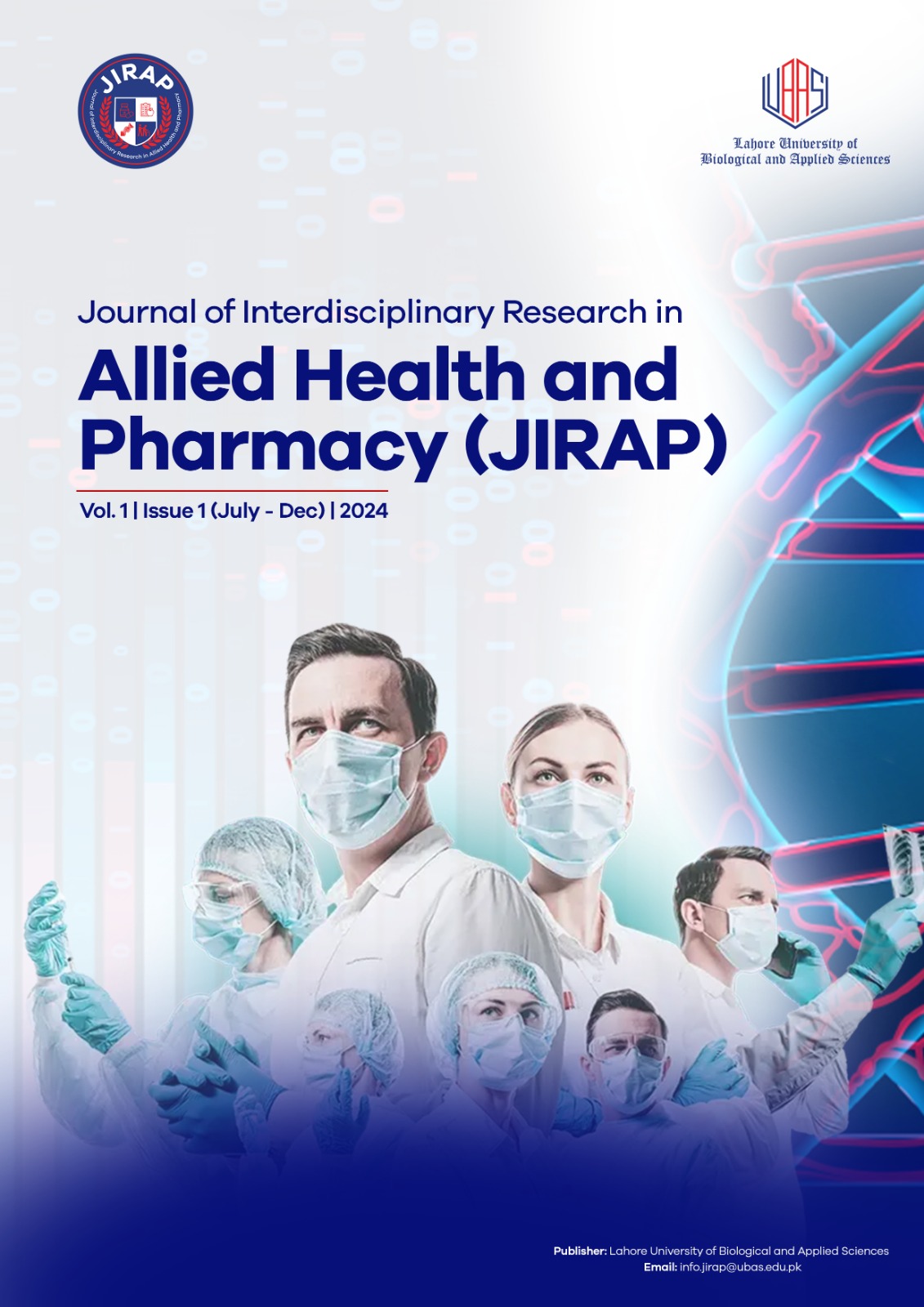Phytochemical Phosphodiesterase Inhibitors: A Comprehensive Review of Molecular Mechanisms and Therapeutic Potential
Keywords:
Phosphodiesterase inhibitors, Phytochemicals, Cyclic nucleotides, Vasodilator, DiseasesAbstract
Phosphodiesterase (PDEs), a superfamily of enzymes, catalyze the hydrolysis of cyclic nucleotides, specifically guanosine 3',5'-cyclic monophosphate (cGMP), adenosine 3',5'-cyclic monophosphate (cAMP) thereby playing a critical role in the precise intracellular signaling cascades regulation and consequently, cellular function. The identification of 11 distinct PDE isoenzyme families, each exhibiting unique substrate specificities, tissue distributions, and regulatory mechanisms, has significantly advanced our understanding of their physiological and pathophysiological roles at the cellular and molecular levels. This increased knowledge has facilitated the way for the emergence of highly selective PDE isoenzyme inhibitors, offering promising therapeutic avenues for a wide range of diseases. PDE inhibitors include many pharmacological agents and they are widely used due to their many pharmacological effects like pleiotropic, vasodilator, cardio tonic, smooth muscle relaxant, antidepressant, anti-inflammatory, antithrombotic and cognitive-enhancing properties. On clinical side, PDE inhibitors have validated efficacy in the management of various conditions, including erectile dysfunction, chronic obstructive pulmonary disease (COPD), and pulmonary arterial hypertension and Alzheimer's disease. Most importantly, with the advancements of indications, states that vast variety of pharmacologically active phytochemicals derived from various plants produce PDE inhibitory activity. All these pharmacologically active phytochemicals belong to the classes of alkaloids, glycosides, phenols and flavonoids which signify a rich reservoir of potential therapeutic agents. This review provides a comprehensive summary of documented phytochemicals which are involved in inhibitory activity of PDE and their diverse roles in the management of specific diseases, emphasizing that various phytochemicals are potential source of PDE inhibition.
References
1. Roks AJM. Phosphodiesterase-1 in the cardiovascular system. Cell Signal. 2022;92:110251.
2. Fu Q, Wang Y, Yan C, Xiang YK. Phosphodiesterase in heart and vessels-From Physiology to Diseases. Physiol Rev. 2024;104(2):765–834.
3. Dunkerly-Eyring B, Kass DA. Myocardial Phosphodiesterases and Their Role in cGMP Regulation. J Cardiovasc Pharmacol. 2020;75(6):483–93.
4. Zhang C, Yu Y, Ruan L, Wang C, Pan J, Klabnik J, et al. The Roles of Phosphodiesterase 2 in the Central Nervous and Peripheral Systems. Curr Pharm Des. 2014;21(3):274–90.
5. Das UN. Arachidonic Acid as Mechanotransducer of Renin Cell Baroreceptor. Nutrients. 2022;14(4):749.
6. Crocetti L, Floresta G, Cilibrizzi A, Giovannoni MP. An Overview of PDE4 Inhibitors in Clinical Trials: 2010 to Early 2022. Molecules. 2022;27(15):4964.
7. Simsek A, Tugcu V, Erturkuner P, Alkan F, Ozbek E, Tasci AI. Effects of the recreational use of PDE5 inhibitors on the corpus cavernosum of young, healthy rats. Int Urol Nephrol. 2014;46(10):1889–93.
8. Ahmad F, Murata T, Shimizu K, Degerman E, Maurice D, Manganiello V. Cyclic nucleotide phosphodiesterases: Important signaling modulators and therapeutic targets. Oral Dis. 2015;21(1):e25–50.
9. Azevedo MF, Faucz FR, Bimpaki E, Horvath A, Levy I, De Alexandre RB, et al. Clinical and molecular genetics of the phosphodiesterases (pdes). Endocr Rev. 2014;35(2):195–233.
10. Oboh G, Adebayo AA, Ademosun AO. Erection-stimulating, anti-diabetic and antioxidant properties of Hunteria umbellata and Cylicodiscus gabunensis water extractable phytochemicals. J Complement Integr Med. 2018;15(1).
11. Ehigiator BE, Adesida AS, Omotuyi IO. Chicoric Acid, a Phytochemical Compound of Solenostemon Monostachyus: Possible Drug Candidate for the Relief of Erectile Dysfunction. Int J Eng Appl Sci Technol. 2020;04(11):509–18.
12. Obode OC, Adebayo AH, Li C. Gas chromatography-mass spectrometry analysis and in vitro inhibitory effects of Phoenix dactylifera L. On key enzymes implicated in hypertension. J Pharm Pharmacogn Res. 2020;8(5):475–90.
13. Jasemi SV, Khazaei H, Aneva IY, Farzaei MH, Echeverría J. Medicinal Plants and Phytochemicals for the Treatment of Pulmonary Hypertension. Front Pharmacol. 2020;11:145.
14. Saikia Q, Hazarika A, Mishra R. A Review on the Pharmacological Importance of PDE5 and Its Inhibition to Manage Biomedical Conditions. J Pharmacol Pharmacother. 2022;13(3):246–57.
15. ElHady AK, El-Gamil DS, Abdel-Halim M, Abadi AH. Advancements in phosphodiesterase 5 inhibitors: unveiling present and future perspectives. Pharmaceuticals. 2023;16(9):1266.
16. Rauf A, Khan IA, Muhammad N, Al-Awthan YS, Bahattab O, Israr M, et al. Phytochemical composition, in vitro urease, α-glucosidase and phosphodiesterase inhibatroy potency of Syzygium cumini (Jamun) fruits. South African J Bot. 2021;143:418–21.
17. Shah ZA, Abu-Izneid T, Rauf A, Rashid U, Nizam M, Muhammad N, et al. Phosphodiesterase 1 inhibition and molecular docking study of phytochemicals isolated from stem heartwood of Heterophragma adenophyllum Seem. South African J Bot. 2020;135:274–9.
18. Zapata FJ, Rebollo-Hernanz M, Novakofski JE, Nakamura MT, Gonzalez de Mejia E. Caffeine, but not other phytochemicals, in mate tea (Ilex paraguariensis St. Hilaire) attenuates high-fat-high-sucrose-diet-driven lipogenesis and body fat accumulation. J Funct Foods. 2020;64:103646.
19. Oboh G, Adebayo AA, Ademosun AO. HPLC phenolic fingerprinting, antioxidant and anti-phosphodiesterase-5 properties of Rauwolfia vomitoria extract. J Basic Clin Physiol Pharmacol. 2019;30(5):20190059.
20. Wang JH, Luan F, He XD, Wang Y, Li MX. Traditional uses and pharmacological properties of Clerodendrum phytochemicals. J Tradit Complement Med. 2018;8(1):24–38.
21. Wahab A, Jan SA, Rauf A, Rehman Z ur, Khan Z, Ahmed A, et al. Phytochemical composition, biological potential and enzyme inhibition activity of Scandix pecten-veneris L. J Zhejiang Univ Sci B. 2018;19(2):120–9.
22. Khanh PN, Huong TT, Spiga O, Trezza A, Son NT, Cuong TD, et al. In silico screening of anthraquinones from Prismatomeris memecyloides as novel phosphodiesterase type-5 inhibitors (PDE-5Is). Rev Int Androl. 2018;16(4):147–58.
23. Lentini A, Tabolacci C, Provenzano B, Rossi S, Beninati S. Phytochemicals and protein-polyamine conjugates by transglutaminase as chemopreventive and chemotherapeutic tools in cancer. Plant Physiol Biochem. 2010;48(7):627–33.
24. Adefegha SA, Oboh G, Olopade EO. Β-Caryophyllene Improves Sexual Performance Via Modulation of Crucial Enzymes Relevant To Erectile Dysfunction in Rats. Toxicol Res. 2021;37(2):249–60.
25. Zhong J, Huang Y, Ding W, Wu X, Wan J, Luo H. Chemical constituents of Aloe barbadensis Miller and their inhibitory effects on phosphodiesterase-4D. Fitoterapia. 2013;91:159–65.
26. Akomolafe SA, Oyeleye SI, Olasehinde TA, Oboh G. Phenolic characterization, antioxidant activities, and inhibitory effects of physalis angulata and newbouldia laevis on enzymes linked to erectile dysfunction. Int J Food Prop. 2018;21(1):645–54.
27. García-Osta A, Cuadrado-Tejedor M, García-Barroso C, Oyarzábal J, Franco R. Phosphodiesterases as therapeutic targets for Alzheimer’s disease. ACS Chem Neurosci. 2012;3(11):832–44.
28. Lines TC, Ono M. FRS 1000, an extract of red onion peel, strongly inhibits phosphodiesterase 5A (PDE 5A). Phytomedicine. 2006;13(4):236–9.
29. Park HJ, Won JEJ, Sorsaburu S, Rivera PD, Lee SW. Urinary Tract Symptoms (LUTS) Secondary to Benign Prostatic Hyperplasia (BPH) and LUTS/BPH with Erectile Dysfunction in Asian Men: A Systematic Review Focusing on Tadalafil. World J Mens Health. 2013;31(3):193.
30. Ismail EA, El-Sakka AI. An overview of conventional and investigational phosphodiesterase 5 inhibitors for treating erectile dysfunction and other conditions. Expert Opin Investig Drugs. 2024;33(9):925–38.
31. Krishnamoorthi R, Ganapathy A A, Hari Priya VM, Kumaran A. Future aspects of plant derived bioactive metabolites as therapeutics to combat benign prostatic hyperplasia. J Ethnopharmacol. 2024;330:118207.
32. Ataei Ataabadi E, Golshiri K, Jüttner A, Krenning G, Danser AHJ, Roks AJM. Nitric Oxide-cGMP Signaling in Hypertension: Current and Future Options for Pharmacotherapy. Hypertension. 2020;76(4):1055–68.

Downloads
Published
License
Copyright (c) 2024 Journal of Interdisciplinary Research in Allied Health and Pharmacy

This work is licensed under a Creative Commons Attribution 4.0 International License.
cc BY






